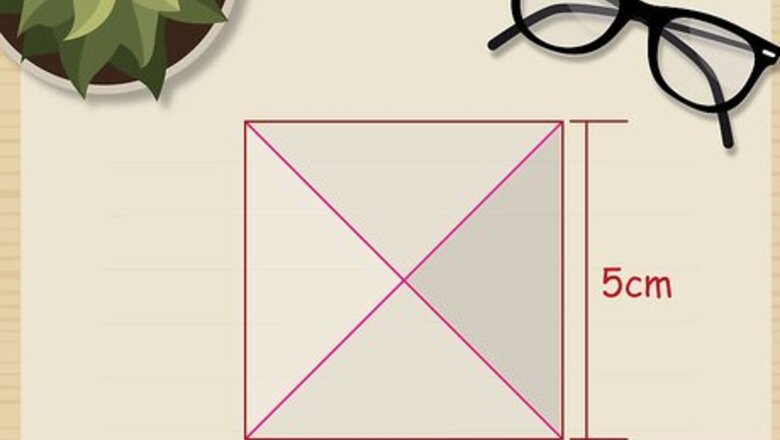
views
s
{\displaystyle s}
represents the length of one of the square base's sides and
h
{\displaystyle h}
represents the height of the pyramid (the perpendicular distance from the base to the point), the volume of a square pyramid can be calculated with the formula
V
=
1
3
s
2
h
{\displaystyle V={\frac {1}{3}}s^{2}h}
. It doesn't matter whether the pyramid is the size of a paperweight or larger than the Great Pyramid of Giza - this formula works for any square pyramid. The volume can also be calculated using what is called the “slant height” of the pyramid.
Finding Volume Using Base Area and Height
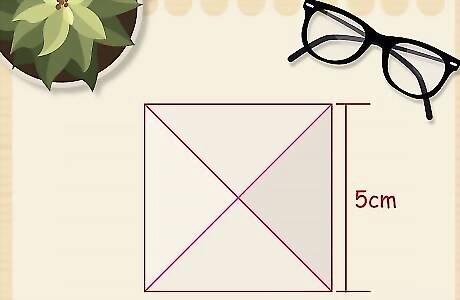
Measure the side length of the base. Since, by definition, square pyramids have bases that are perfectly square, all of the sides of the base should be equal in length. Thus, for a square pyramid, you only need to find the length of one side. Consider a pyramid whose base is a square with side lengths of s = 5 cm {\displaystyle s=5{\text{cm}}} s=5{\text{cm}}. This is the value you will use to find the area of the base. If the sides of the base are not equal in length, you have a rectangular pyramid rather than a square pyramid. The volume formula for rectangular pyramids is very similar to the formula for square pyramids. If l {\displaystyle l} l represents the length of the rectangular pyramid's base and w {\displaystyle w} w represents its width, the pyramid's volume is V = 1 3 h ∗ l ∗ w {\displaystyle V={\frac {1}{3}}h*l*w} V={\frac {1}{3}}h*l*w.
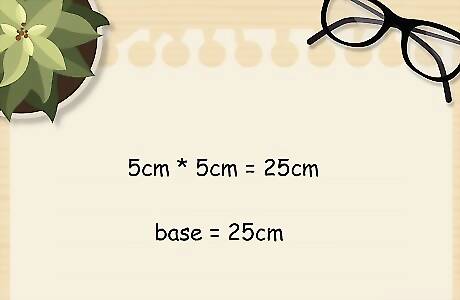
Calculate the area of the base. Finding the volume begins by finding the two-dimensional area of the base. This is done by multiplying the base's length times its width. Because the base of a square pyramid is a square, its sides all have equal lengths, so the area of the base is equal to the length of one side squared (times itself). In the example, since the side lengths of the pyramid's base are all 5 cm, you can find the base's area as: area = s 2 = ( 5 cm ) 2 = 25 cm 2 {\displaystyle {\text{area}}=s^{2}=(5{\text{cm}})^{2}=25{\text{cm}}^{2}} {\text{area}}=s^{2}=(5{\text{cm}})^{2}=25{\text{cm}}^{2} Remember that two-dimensional areas are expressed in square units - square centimeters, square meters, square miles, and so on.
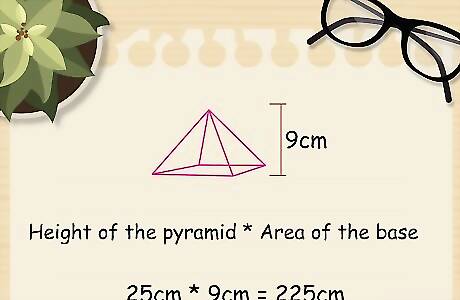
Multiply the area of the base by the pyramid's height. Next, multiply the base area by the height of the pyramid. As a reminder, the height is the distance of the line segment stretching from the apex of the pyramid to the plane of the base at perpendicular angles to both. In the example, suppose the pyramid has a height of 9 cm. In this case, multiply the area of the base by this value as follows: 25 cm 2 ∗ 9 cm = 225 cm 3 {\displaystyle 25{\text{cm}}^{2}*9{\text{cm}}=225{\text{cm}}^{3}} 25{\text{cm}}^{2}*9{\text{cm}}=225{\text{cm}}^{3} Remember that volumes are expressed in cubic units. In this case, because all the linear measurements are centimeters, the volume is in cubic centimeters.
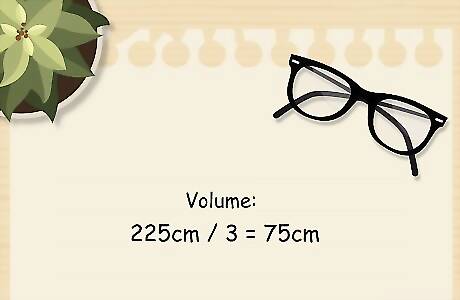
Divide this answer by 3. Finally, find the volume of the pyramid by dividing the value you just found from multiplying the base area by the height by 3. This will give you a final answer that represents the volume of the square pyramid. In the example, divide 225 cm by 3 to get an answer of 75 cm for the volume. EXPERT TIP Joseph Meyer Joseph Meyer Math Teacher Joseph Meyer is a High School Math Teacher based in Pittsburgh, Pennsylvania. He is an educator at City Charter High School, where he has been teaching for over 7 years. Joseph is also the founder of Sandbox Math, an online learning community dedicated to helping students succeed in Algebra. His site is set apart by its focus on fostering genuine comprehension through step-by-step understanding (instead of just getting the correct final answer), enabling learners to identify and overcome misunderstandings and confidently take on any test they face. He received his MA in Physics from Case Western Reserve University and his BA in Physics from Baldwin Wallace University. Joseph Meyer Joseph Meyer Math Teacher To find a pyramid's volume, use the formula (1/3) ∗ {\displaystyle *} * Base Area ∗ {\displaystyle *} * Height. Measure a pyramid's height from its tip to the base's center. Next, find the base area using the correct formula for the base shape, whether a triangle, square, or rectangle. Finally, input these values into the formula to calculate volume.
Finding Volume Using Slant Height
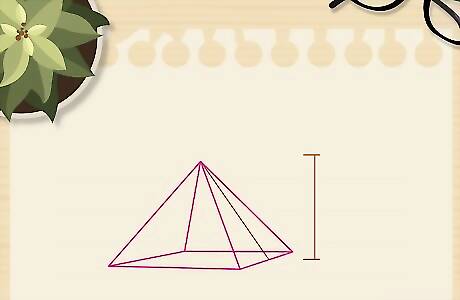
Measure the pyramid's slant height. Sometimes you will not be told the perpendicular height of the pyramid. Instead, you may be told - or may have to measure - the pyramid’s slant height. With the slant height, you will be able to use the Pythagorean Theorem to calculate the perpendicular height. A pyramid's slant height is the distance from its apex to the midpoint of one of the base sides. Measure to the midpoint of the side and not to one of the corners of the base. For this example, assume that you measure the slant height to be 13 cm, and you are told that the side length is 10 cm. As a reminder, the Pythagorean Theorem can be expressed as the equation a 2 + b 2 = c 2 {\displaystyle a^{2}+b^{2}=c^{2}} a^{2}+b^{2}=c^{2}, where a {\displaystyle a} a and b {\displaystyle b} b are the perpendicular legs of the right triangle and c {\displaystyle c} c is the hypotenuse.
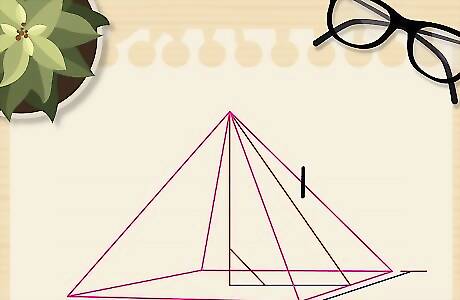
Imagine a right triangle. To use the Pythagorean Theorem, you need a right triangle. Imagine a right triangle slicing through the middle of the pyramid and perpendicular to the base of the pyramid. The slant height of the pyramid, called l {\displaystyle l} l, is the hypotenuse of this right triangle. The base of this right triangle is one half the length of s {\displaystyle s} s, the side of the square base of the pyramid.
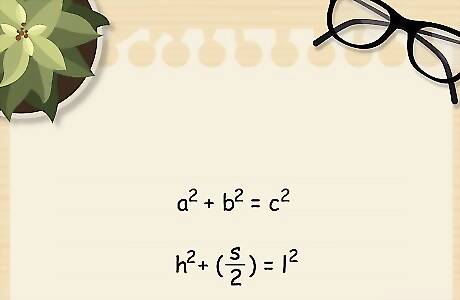
Assign variables to the values. The Pythagorean Theorem uses the variables a, b, and c, but it helps to replace those with variables that have meaning for your problem. The slant height l {\displaystyle l} l takes the place of c {\displaystyle c} c in the Pythagorean Theorem. The leg of the right triangle, which is s 2 {\displaystyle {\frac {s}{2}}} {\frac {s}{2}}, takes the place of b . {\displaystyle b.} b. You will be solving for the height of the pyramid, h {\displaystyle h} h, which takes the place of a {\displaystyle a} a in the Pythagorean Theorem. This substitution will look like this: a 2 + b 2 = c 2 {\displaystyle a^{2}+b^{2}=c^{2}} a^{2}+b^{2}=c^{2} h 2 + ( s 2 ) 2 = l 2 {\displaystyle h^{2}+({\frac {s}{2}})^{2}=l^{2}} h^{2}+({\frac {s}{2}})^{2}=l^{2}
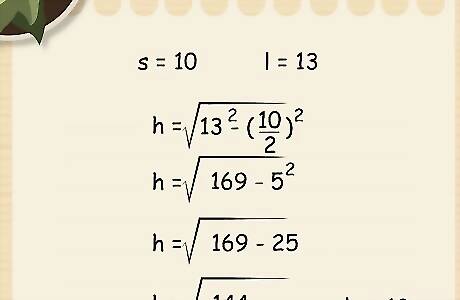
Use the Pythagorean Theorem to calculate the perpendicular height. Insert the measured values of s = 10 {\displaystyle s=10} s=10 and l = 13 {\displaystyle l=13} l=13. Then proceed to solve the equation: h 2 = l 2 − ( s 2 ) 2 {\displaystyle h^{2}=l^{2}-({\frac {s}{2}})^{2}} h^{2}=l^{2}-({\frac {s}{2}})^{2}.....(original equation) h = l 2 − ( s 2 ) 2 {\displaystyle h={\sqrt {l^{2}-({\frac {s}{2}})^{2}}}} h={\sqrt {l^{2}-({\frac {s}{2}})^{2}}}.....(square root both sides) h = 13 2 − ( 10 2 ) 2 {\displaystyle h={\sqrt {13^{2}-({\frac {10}{2}})^{2}}}} h={\sqrt {13^{2}-({\frac {10}{2}})^{2}}}.....(substitute values) h = 169 − 5 2 {\displaystyle h={\sqrt {169-5^{2}}}} h={\sqrt {169-5^{2}}}.....(simplify fraction) h = 169 − 25 {\displaystyle h={\sqrt {169-25}}} h={\sqrt {169-25}}.....(simplify square) h = 144 {\displaystyle h={\sqrt {144}}} h={\sqrt {144}}.....(subtract) h = 12 {\displaystyle h=12} h=12.....(simplify square root)
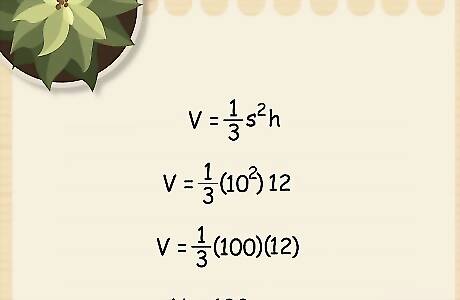
Use the height and base to calculate volume. After using the calculations with the Pythagorean Theorem, you now have the information you need to calculate the volume of the pyramid as you normally would. Use the formula V = 1 3 s 2 h {\displaystyle V={\frac {1}{3}}s^{2}h} V={\frac {1}{3}}s^{2}h and solve, making sure to label your answer in cubic units. From the calculations, the height of the pyramid is 12 cm. Use this and the base side of 10 cm. to calculate the pyramid's volume: V = 1 3 s 2 h {\displaystyle V={\frac {1}{3}}s^{2}h} V={\frac {1}{3}}s^{2}h V = 1 3 ( 10 2 ) 12 {\displaystyle V={\frac {1}{3}}(10^{2})12} V={\frac {1}{3}}(10^{2})12 V = 1 3 ( 100 ) ( 12 ) {\displaystyle V={\frac {1}{3}}(100)(12)} V={\frac {1}{3}}(100)(12) V = 400 cm 3 {\displaystyle V=400{\text{cm}}^{3}} V=400{\text{cm}}^{3}
Finding Volume Using the Edge Height
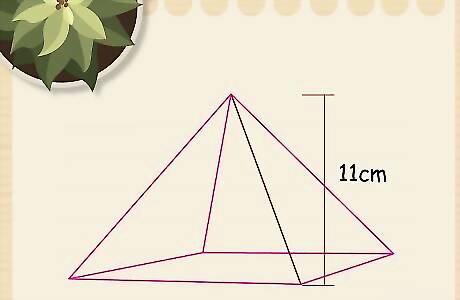
Measure the pyramid’s edge height. The edge height is the length of the edge of the pyramid, measured from the apex to one of the corners of the pyramid’s base. As before, you will then use the Pythagorean Theorem to calculate the perpendicular height of the pyramid. For this example, assume that the edge height can be measured to be 11 cm and you are given that the perpendicular height is 5 cm.
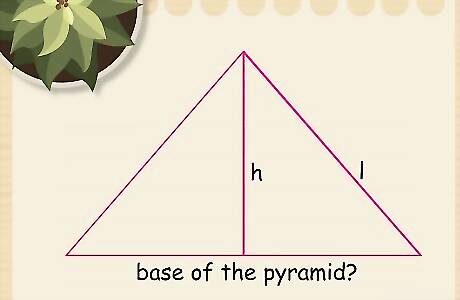
Imagine a right triangle. As before, you need a right triangle to use the Pythagorean Theorem. In this case, however, your unknown value is the base of the pyramid. You know the perpendicular height and the edge height. If you imagine cutting the pyramid diagonally from one corner to the opposite corner and opening it up, the exposed inside face is a triangle. The height of that triangle is the perpendicular height of the pyramid. It divides the exposed triangle into two symmetrical right triangles. The hypotenuse of either right triangle is the edge height of the pyramid. The base of either right triangle is one-half the diagonal of the base of the pyramid.

Assign variables. Use this imaginary right triangle and assign values to the Pythagorean Theorem. You know the perpendicular height, h , {\displaystyle h,} h, which is one leg of the Pythagorean Theorem, a {\displaystyle a} a. The edge height of the pyramid, l , {\displaystyle l,} l, is the hypotenuse of this imaginary right triangle, so it takes the place of c {\displaystyle c} c. The unknown diagonal of the base of the pyramid is the remaining leg of the right triangle, b . {\displaystyle b.} b. After you make these substitutions, the equation will look like this: a 2 + b 2 = c 2 {\displaystyle a^{2}+b^{2}=c^{2}} a^{2}+b^{2}=c^{2} h 2 + b 2 = l 2 {\displaystyle h^{2}+b^{2}=l^{2}} h^{2}+b^{2}=l^{2}

Calculate the diagonal of the square base. You will need to rearrange the equation to isolate the variable b {\displaystyle b} b and then solve for its value. h 2 + b 2 = l 2 {\displaystyle h^{2}+b^{2}=l^{2}} h^{2}+b^{2}=l^{2}..........(revised equation) b 2 = l 2 − h 2 {\displaystyle b^{2}=l^{2}-h^{2}} b^{2}=l^{2}-h^{2}..........(substitute h from both sides) b = l 2 − h 2 {\displaystyle b={\sqrt {l^{2}-h^{2}}}} b={\sqrt {l^{2}-h^{2}}}..........(square root both sides) b = 11 2 − 5 2 {\displaystyle b={\sqrt {11^{2}-5^{2}}}} b={\sqrt {11^{2}-5^{2}}}..........(insert numerical values) b = 121 − 25 {\displaystyle b={\sqrt {121-25}}} b={\sqrt {121-25}}..........(simplify squares) b = 96 {\displaystyle b={\sqrt {96}}} b={\sqrt {96}}..........(subtract values) b = 9.80 {\displaystyle b=9.80} b=9.80..........(simplify square root) Double this value to find the diagonal of the square base of the pyramid. Thus, the diagonal of the pyramid’s base is 9.8*2=19.6 cm.
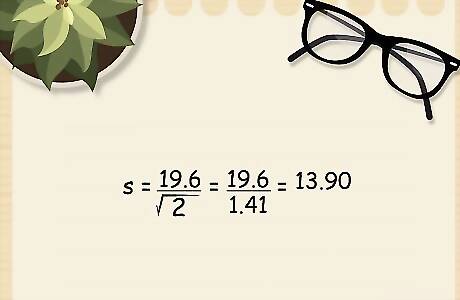
Find the side of the base from the diagonal. The base of the pyramid is a square. The diagonal of any square is equal to the length of a side times the square root of 2. Conversely, you can find the side of the square from its diagonal by dividing by the square root of 2. For this sample pyramid, the diagonal has been calculated to be 19.6 cm. Therefore, the side is equal to: s = 19.6 2 = 19.6 1.41 = 13.90 {\displaystyle s={\frac {19.6}{\sqrt {2}}}={\frac {19.6}{1.41}}=13.90} s={\frac {19.6}{{\sqrt {2}}}}={\frac {19.6}{1.41}}=13.90
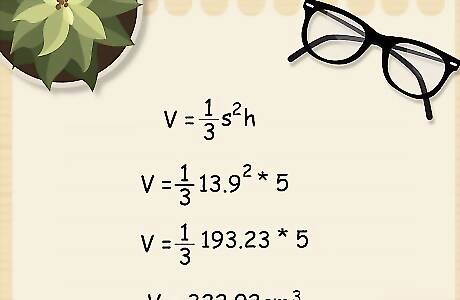
Use the side and height to calculate volume. Return to the original formula to calculate the volume using the side and perpendicular height. V = 1 3 s 2 h {\displaystyle V={\frac {1}{3}}s^{2}h} V={\frac {1}{3}}s^{2}h V = 1 3 13.9 2 ∗ 5 {\displaystyle V={\frac {1}{3}}13.9^{2}*5} V={\frac {1}{3}}13.9^{2}*5 V = 1 3 193.23 ∗ 5 {\displaystyle V={\frac {1}{3}}193.23*5} V={\frac {1}{3}}193.23*5 V = 322.02 cm 3 {\displaystyle V=322.02{\text{cm}}^{3}} V=322.02{\text{cm}}^{3}



















Comments
0 comment